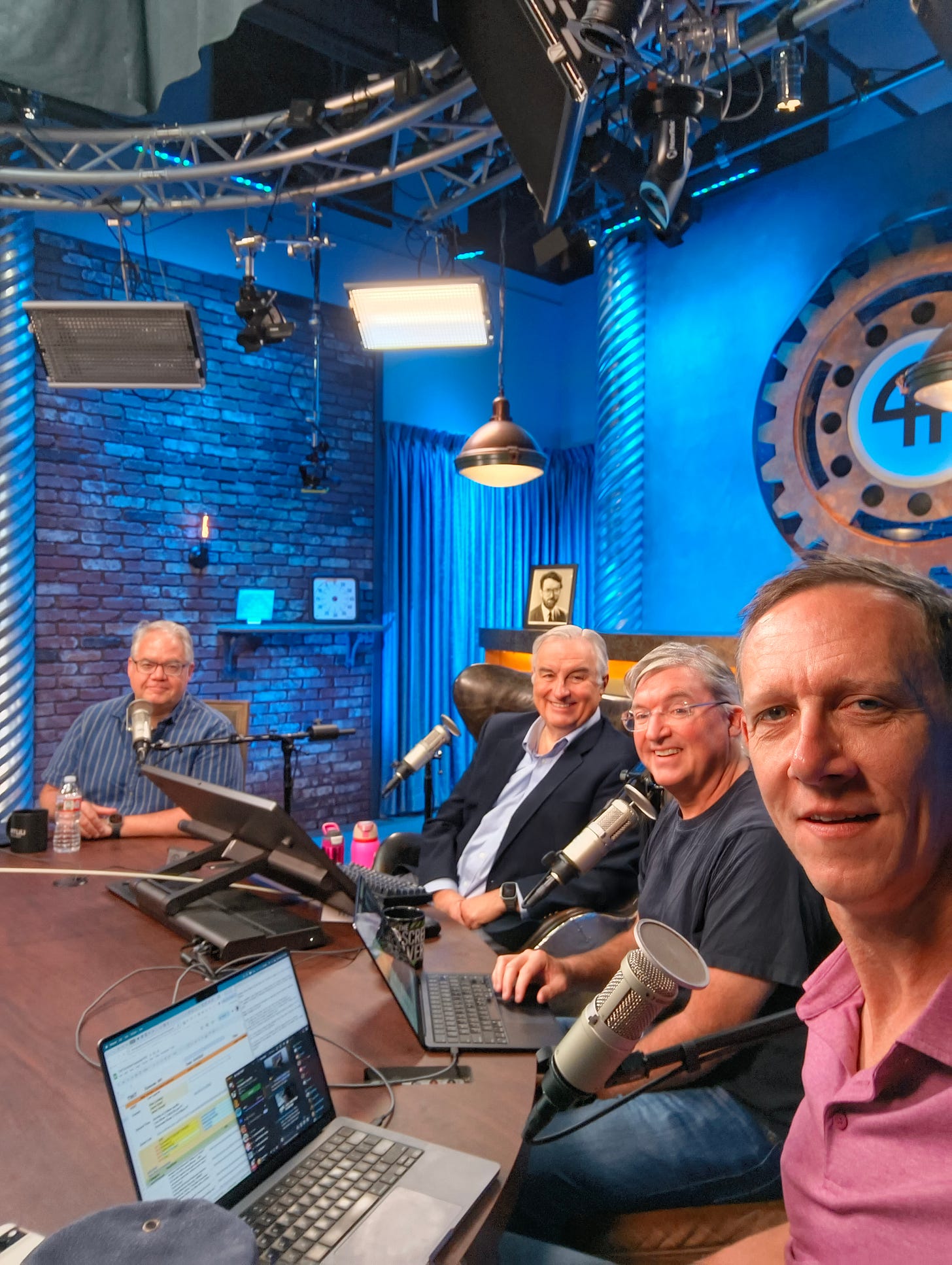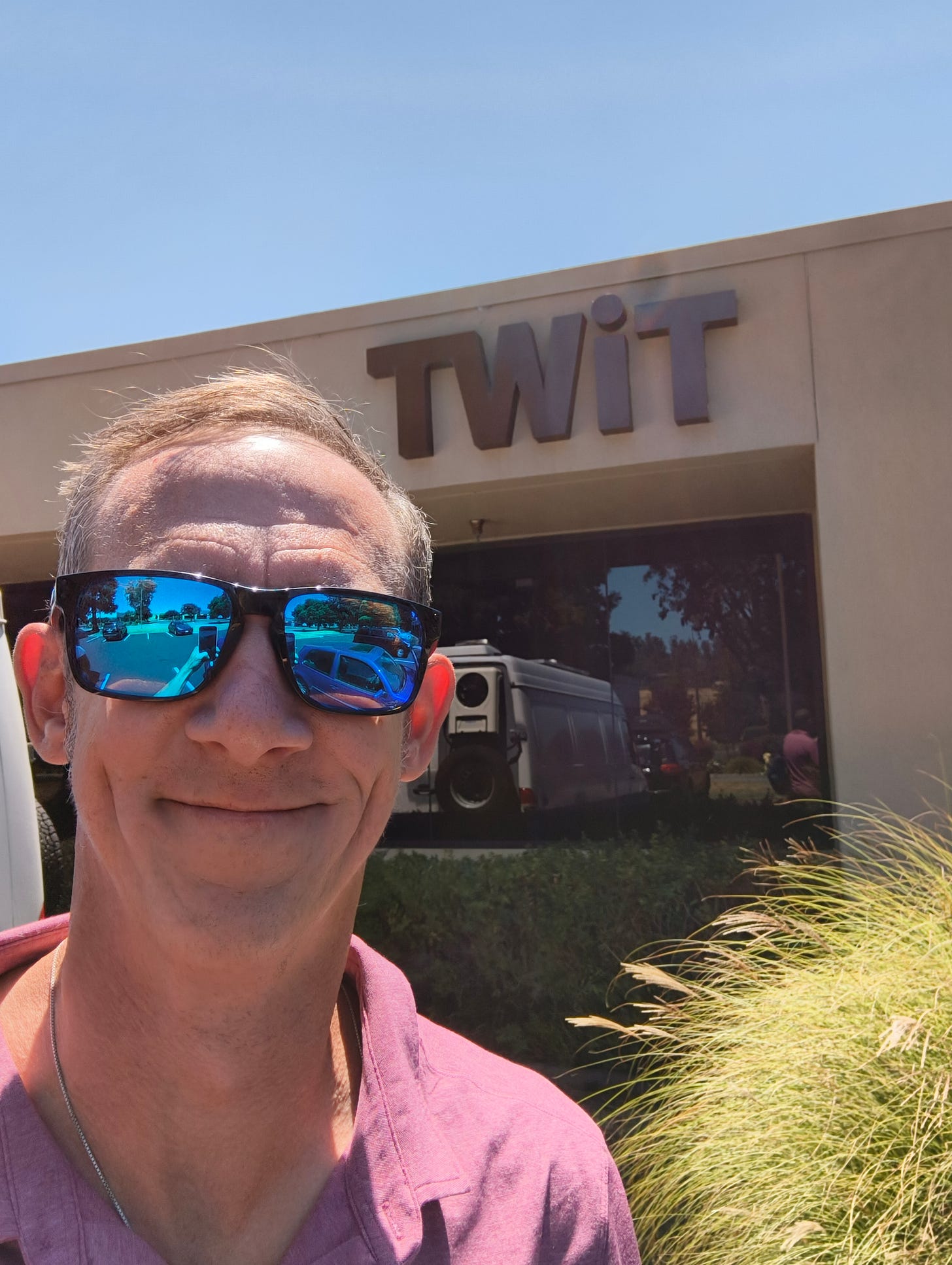I'm now one day beyond being a guest on the very last in-studio episode of This Week in Tech. Or rather, the very last episode in the Eastside Studios. I hate to put an absolute cap on the possibility that TWiT might have another studio in the future, but at this point, it seems like TWiT is making the difficult but necessary move to go fully virtual.
It was a fun episode as I joined Leo Laporte, Jason Snell, and Alex Lindsay on the set, with some of the week’s biggest stories, and of course, that tangible quality that you get when you bring four people into the same physical space for a conversation about a topic they all follow and love deeply.
There's a real difference between what you get when people are in the same room talking versus what you get when people are online staring into a camera or talking into a microphone. One big difference is the latency that's an inevitable part of fully virtual podcasting. That latency is something you don't get at all when everybody's in the same physical space. You also get the ability to read each other's facial expressions and body language. Sometimes so much of what is spoken isn't said in words at all. It's shown in reactions, and that's much clearer and easier to perceive and feed off of when everyone is in the same room.
Being online, however, has changed a lot in the last handful of years, in regard to podcasting and live streaming. The start of COVID ushered in a widespread acceptance of the process of looking at a screen full of real live people (who are also looking at a screen full of real live people) and finding some way to converse comfortably. Sometimes that flow is hard to capture. Before COVID, that stilted air was the norm and not the exception. Now, post-COVID, it seems like many more people have at least a working understanding of the challenges of video streaming online and live video conferences, and have largely worked through it enough to at least carry on a conversation without much of that weirdness attached to it.
But it's still not perfect.
People who rely on this technology to do their podcasts and their live shows have had to strengthen that muscle to lean into the fully virtual space that we find ourselves in. The large studio that TWiT has had almost since the very beginning was at one point somewhat necessary considering the complexity that was taking place behind it. It was the model that Leo Laporte built the company after. Besides, his background was in TV and radio. In the early 2000s, practically all of that was done in an official studio environment.
But even before COVID, online technology and streaming technology had improved to a point where a live studio environment was “nice to have,” but not entirely necessary. In some ways, it was a powerful flex to show how big a podcast network could be, and the business could support that. Post-COVID, it started to become more of a liability, an albatross.
One thing is clear to me right now: We have all grown to accept “less than perfect” when it comes to podcasts and live streaming. Our ability to forgive less-than-ideal microphones or not quite 4K sharp video in live streams is much higher now than it was before COVID. Partially, because we’ve all interacted with the Zooms and the Teams enough to know that our setups aren’t perfect, and yet the calls we made ended up fine despite that.
Quality entry-level microphones are now less expensive than ever before. Video switchers cost a few hundred dollars instead of multiple thousands of dollars. Heck, you can install OBS for free and you have an incredibly capable and flexible setup for most of what you might want to do streaming from home. I think that in the end, a lot of people have just realized for themselves that all the BEST equipment and adherence to the highest quality standards is not entirely necessary. We’ve conditioned ourselves to accept less than perfect. And that’s ok.
This is evident when you watch live newscasts on television. Once upon a time, guests were required to book time in a costly facility that could transmit high-quality video and audio in the formats that the major studios required. Now, it's very common to see reporters and pundits calling into television news shows wearing AirPods and using the webcam on their laptops. This would have been a mortal sin even ten years ago. Now it’s commonplace.
What it illustrates to me is that at the end of the day, the message is what's most important. If you can deliver the message and things sound amazing and look amazing, well, that's great. There's nothing wrong with that. But the look and sound being as good as it possibly can isn't an absolute requirement for the needs of many (most?) listeners and watchers the way it was once assumed to be the case. Because we've all been through the wringer with this technology post-COVID, we all know what it takes and we've all accepted a lower standard.
Now, none of this is to say that TWiT going fully virtualized will lead to lower quality anything. I know and highly respect the talent and the engineers who are getting the technology in place to support Leo Laporte and the crew in doing their podcasts from home. I know for a fact it's going to look and sound excellent. It's just not going to look and sound like the Eastside Studios or the Brick House that came before it. And at the end of the day, that's okay. The people who support TWiT, and I count myself as one of them, want to see it succeed, and a change from the studio environment to a home environment won't change that one bit.
It was very surreal being at the Eastside Studios yesterday and seeing all of the equipment in various states of disassembly. Tables filled with equipment that cost insane amounts of money over the few decades that TWiT has been doing the large-scale studio podcast game.
There's a part of it that is, yes, sad to me in the way that change can often be sad. All of my time spent at TWiT was done in some sort of a large studio setting and a large-scale operation, filled with many engineers to help keep it running.
Yes, it's sad that things have to change. But at the end of the day, I don't see it as an experiment that failed. I believe that TWiT did what made sense at the time. And up until the last handful of years, the studio model was exactly the right approach. Because the business was able to survive and THRIVE for 20-plus years with that model. There is no failure in that.
Now, TWiT is doing what it needs to do to be viable for the next, who knows how long. I’m excited to watch the next chapter unfold.





